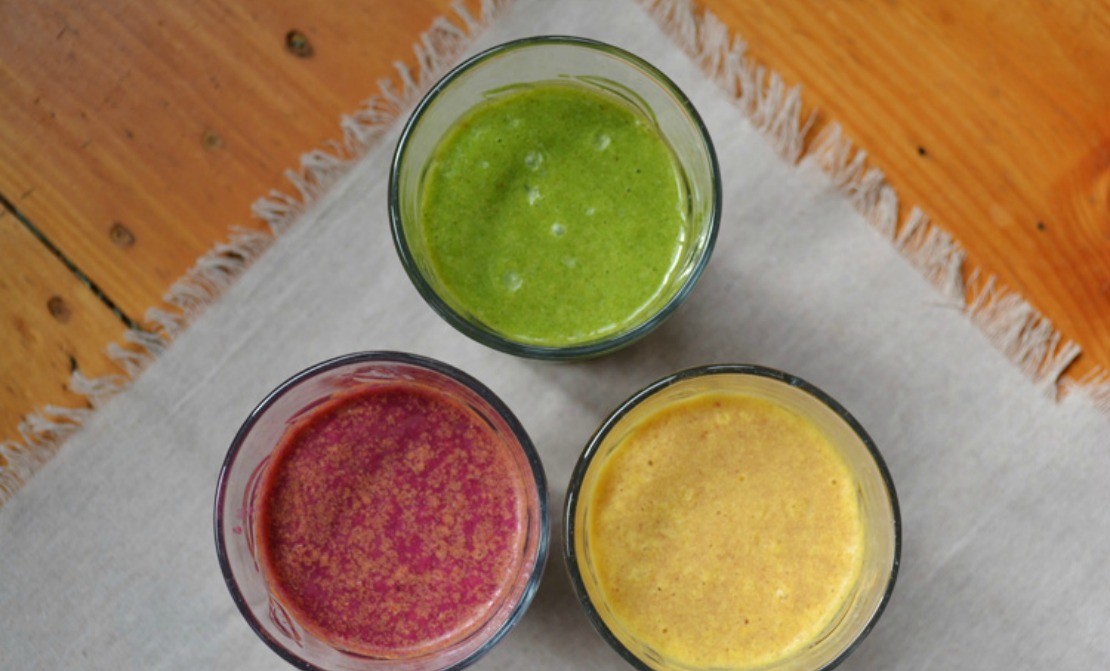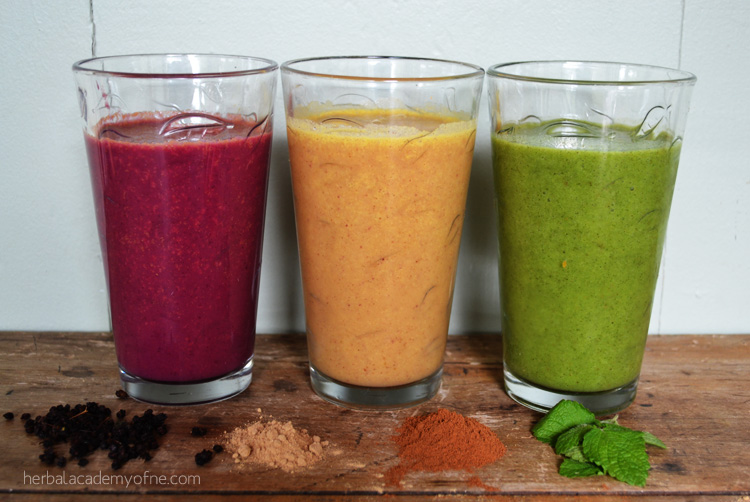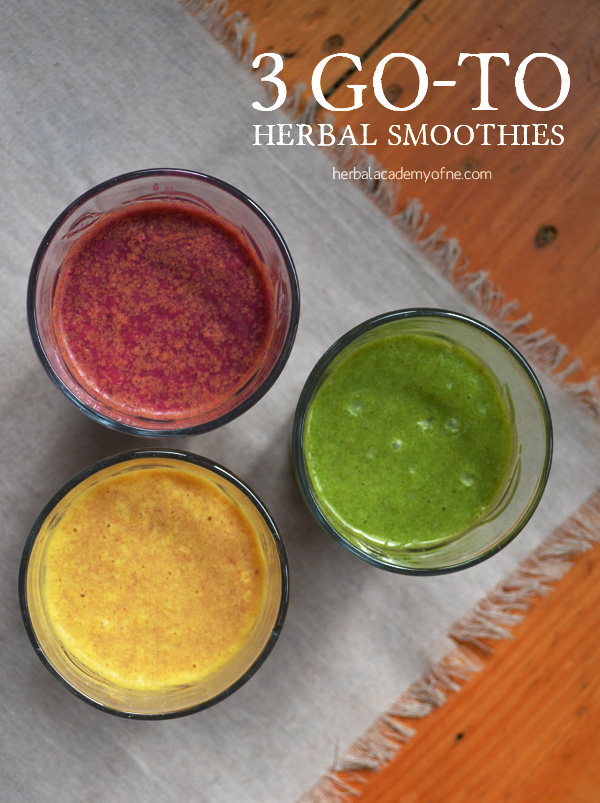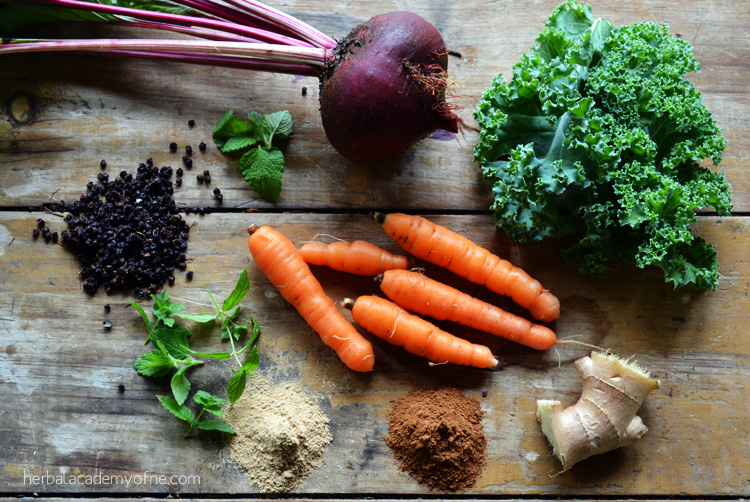
3 Go-To Herbal Smoothies
Smoothies are all the rage, and for good reason — they’re easy and delicious! Made with fresh, high quality ingredients, they’re loaded with vitamins, minerals, and antioxidants, qualifying them for food-as-medicine status. But beware: in the realm of smoothies, there are those that are just wolves in sheep’s clothing! Many smoothies are so loaded with sugar and dairy that nutritionally they’re not that different from a strawberry milkshake, so it’s nice to make them at home and know exactly what’s going into the blender.
Deconstructing Herbal Smoothies
You can certainly pack a lot of supplements and super foods in one smoothie, but for the sake of the digestive system I like to keep them fairly simple, and approach smoothie construction as a combination the following parts:
• Fruits – Berries, mangos, peaches, strawberries, bananas, grapes, apples – the options are limitless, and provide a powerful punch of vitamins, minerals, and antioxidants. Freeze fresh local fruit or buy frozen fruit to keep the smoothie cold.
• Vegetables – Kale, spinach, beets and carrots are smoothie superstars! They’re nutrition powerhouses and add really nice flavor.
• Nourishing herbal infusions – Herbal infusions are made from nourishing herbs such as nettle, oatstraw, red clover, chickweed, and violet leaf and are rich sources of vitamins, minerals, micronutrients and/or protein. Infusions are made from 1 ounce of herb steeped in 1 quart boiling water for at least 4 hours, so can have a strong taste; the flavors of nettle and oat straw seem to meld into a smoothie nicely. Herbal tonics made with hawthorn and elderberry or other vitamin-rich herbs such as rose hips and hibiscus are also nice additions.
• Digestive Herbs – Ginger, peppermint, lemon balm, anise, cinnamon, and cardamom stimulate and support healthy digestion and soothe digestive imbalances such as indigestion, gas, or cramping. Oh, and they taste good!
• Non-dairy milk or yogurt – Non-dairy milk or yogurt add protein and a creamy texture to smoothies, and yogurt has the added benefit of probiotics. The recipes call for rice milk, which has a light, neutral taste, but you can choose whichever milk you prefer — rice, almond, coconut, hemp, soy… You can also substitute yogurt for some of the milk.
• Coconut oil – Coconut oil is delicious, and since it is solid at room temperature, it adds a creamy element to a smoothie. It’s known to increase HDL (good) cholesterol and thus improve the overall cholesterol ratio, and also has antioxidant effect on the body.
• Sweetener – Dates add sweetness, fiber, vitamins, and minerals. Honey, maple syrup, or stevia are also nice.

Green Nettle Mint Smoothie
1 C frozen mango
3/4 C nettle infusion (cold or room temperature)
3/4 C rice milk
1 tbsp coconut oil
5 mint leaves
4 pitted dates
- Blend all ingredients thoroughly in a blender until smooth.
- Garnish with a mint leaf.
Beet Berry Hemp Smoothie
1 small carrot
1 C frozen mixed berries
1/2 C elderberry infusion (or 2 tsp dried elderberries plus 1/2 C water)
1 C rice milk
2 tbsp hemp seeds
1 tbsp coconut oil
1-2 tsp fresh ginger root
4 pitted dates
- Peel and quarter the beet.
- Blend all ingredients thoroughly in a blender until smooth.
Peach Maca Smoothie
1 medium carrot
1/2 C oatstraw infusion (cold or room temperature) or water
1 C rice milk
1 tbsp coconut oil
1 tsp maca powder
1/2 tsp cinnamon (optional)
4 pitted dates
- Blend all ingredients thoroughly in a blender until smooth.
These recipes give you some ideas but are just the tip of the iceberg! Choose your favorite fruit, vegetable, nourishing herb and digestive herb and tailor a smoothie to your tastes. How about a chai smoothie with bananas, chaga decoction, ginger, cinnamon and nutmeg? Or a Creamsicle Vitamin C smoothie with orange juice, vanilla yogurt, rose hip tea and lemon balm? I think I feel another smoothie blog post coming on!









